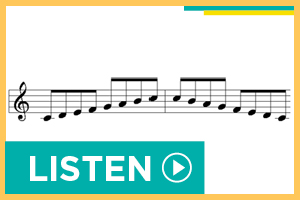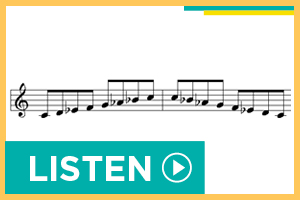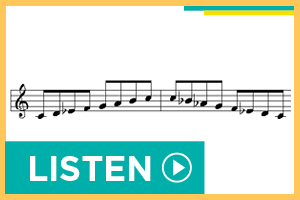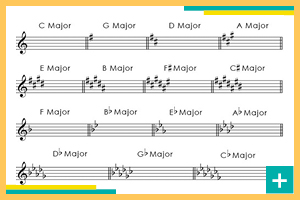Building blocks
C MAJOR SCALE
A major scale is made up of seven notes, starting with the Key Note (or Tonic). As the notes go up, they follow this sequence of steps:
Key Note, whole, whole, half, whole, whole, whole, half
The eighth note of the scale duplicates the first one at twice the frequency. This is called an octave of the same note (from the Latin “octavus”, meaning “the eighth”).
A C major scale has no sharps or flats, and can be played on a piano using just the white keys. It starts on the Key Note of “C”.
C MINOR SCALE
The natural minor scale follows this sequence of steps as it goes up:
Key Note, whole, half, whole, whole, half, whole, whole
The natural minor scale can also be represented by using scale degree numbers:
1 2 b3 4 5 b6 b7 8
To play a natural minor key on the piano with no sharps or flats, you can start on the Key Note of “A”. A minor is known as the “relative minor” of C major. Every major key has its own relative minor, which can be played by starting and ending on the sixth note of the major scale.
C MELODIC MINOR SCALE
A melodic minor scale is made up of seven notes, starting with the Key Note (or Tonic). As the notes go up, they follow this sequence of steps:
Key Note, Whole, Half, Whole, Whole, Half, Whole-and-a-half, Half
Using scale degree numbers, it looks like this:
1 2 b3 4 5 6 7 8
As the notes go down, they follow a different pattern:
Key Note, Whole, Whole, Half, Whole, Whole, Half, Whole Step
Using scale degree numbers, it looks like this:
1 2 b3 4 5 b6 b7 8
Many composers consider melodic minor scales better than other minor scales for creating smooth melodies. They are found in lots of music, both classical and popular.
(There is no way to play a melodic minor scale on the piano using only the white keys).
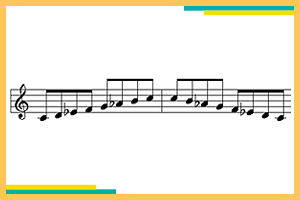
C HARMONIC MINOR SCALE
The notes of the harmonic minor scale are the same as the natural minor, except that the seventh degree is raised by an extra half step. This creates a distinctive interval, known as an “augmented second,” between the sixth and seventh degrees of the scale.
A harmonic minor scale follows this sequence of steps:
Key Note, Whole, Half, Whole, Whole, Half, Whole-and-a-half, Half
Using scale degree numbers, it looks like this:
1 2 b3 4 5 b6 7 8.
This scale is called “harmonic” because its notes provide a common foundation for harmonies (or chords) used in a minor key.
(There is no way to play a melodic minor scale on the piano using only the white keys).
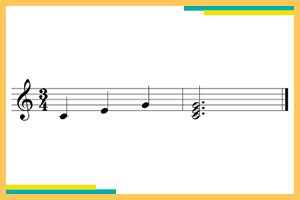
C MAJOR CHORD (TRIAD)
A C major chord, also known as a C major triad, is comprised of three specific pitches: C, E, and G. Each pitch is known by its position in the C major scale: C is the root of the chord, E is the third of the chord, and G is the 5th.
The major triad (or major chord), along with the minor triad (or minor chord), is one of the basic building blocks of tonal music, and is found in all Western pop, folk and rock music.
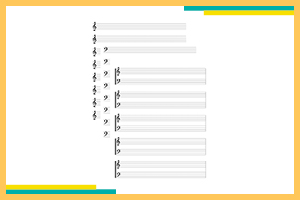
BLANK SHEET MUSIC – STAFF PAPER
Blank Sheet Music – Treble Clef
Blank Sheet Music – Bass Clef
Blank Sheet Music – Grand Staff
Print out and use as blank staff paper to write your own music.

HOW HEARING WORKS
Sound from a trumpet starts when a players lips vibrate against a mouthpiece. The brass tubes of a trumpet help the air vibrate at a certain pitch and make it louder. Sound is actually air that vibrates, or changes pressure very quickly (20 to 20,000 times a second), and travels as a sound wave.
The outer ear (Pinna) catches the sound wave and directs it into the inner ear, where the ear drum (Tympanic Membrane) is. The ear drum vibrates the Ossicles (three bones called the Hammer, Anvil, and Stirrup). They act as a lever which pushes against the Vestibule and moves the fluid inside to the Cochlea. The tiny hairs in the cochlea turn this pressure into electrical signals, which is then sent to the brain, using the cochlear nerve. The brain accepts the electrical signals and recognizes that it is a trumpet.
Ear artwork provided by: H.E.A.R.- Hearing Education and Awareness for Rockers, a non profit organization. CLICK TO DOWNLOAD
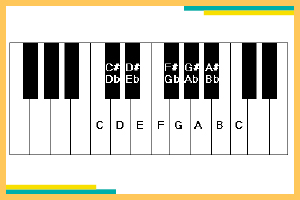
WHOLE STEPS & HALF STEPS
All scales are made up of a series of Whole Steps and Half Steps.
A half step is the smallest interval between two notes on a piano. Look at the diagram below and notice how the notes are laid out. Moving up from C, C# (or C sharp) is the very next key to the right, and it happens to be a black key.
Flats are defined as the note that is one half step lower than the note you are starting on. So, Db (or D flat) is the next key to the left of D.
A whole step is made up of two half steps. So moving up from C to D would be considered a whole step. E to F# is also a whole step, as is Bb to C.
Did you notice that C# and Db are the same note??? All notes have more than one name. What you call them depends on what Key you are in.
KEYS & KEY SIGNATURES
Most music is in what is called a Key (for example ‚ÄúC major‚ÄĚ or ‚ÄúE minor‚ÄĚ). The Key Note (also called the tonic) acts like a ‚Äúcenter of gravity‚ÄĚ for a piece of music. When a melody lands on the key note, it usually feels at rest. As examples, the key note in the key of C major is ‚ÄúC‚ÄĚ, while the key note in the key of E minor is ‚ÄúE‚ÄĚ.
A Key Signature is a pattern of sharps and flats at the beginning of a line of music that tells a musician which notes should be flat and which should be sharp.
Sometimes people confuse musical keys with musical scales, but they are not quite the same. A scale is a series of notes that always starts on the key note, and follows the pattern of sharps and flats for that key. So a scale is always in a particular key, but a key can never be in a scale!
CLICK TO DOWNLOAD
